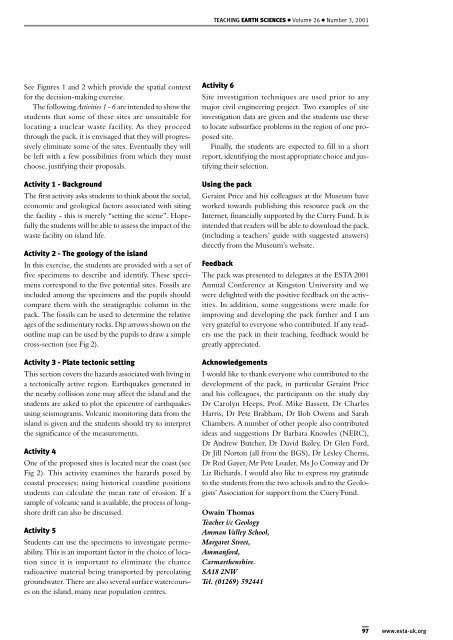teaching - Earth Science Teachers' Association
teaching - Earth Science Teachers' Association
teaching - Earth Science Teachers' Association
Create successful ePaper yourself
Turn your PDF publications into a flip-book with our unique Google optimized e-Paper software.
TEACHING EARTH SCIENCES ● Volume 26 ● Number 3, 2001<br />
See Figures 1 and 2 which provide the spatial context<br />
for the decision-making exercise.<br />
The following Activities 1 - 6 are intended to show the<br />
students that some of these sites are unsuitable for<br />
locating a nuclear waste facility. As they proceed<br />
through the pack, it is envisaged that they will progressively<br />
eliminate some of the sites. Eventually they will<br />
be left with a few possibilities from which they must<br />
choose, justifying their proposals.<br />
Activity 1 - Background<br />
The first activity asks students to think about the social,<br />
economic and geological factors associated with siting<br />
the facility - this is merely “setting the scene”. Hopefully<br />
the students will be able to assess the impact of the<br />
waste facility on island life.<br />
Activity 2 - The geology of the island<br />
In this exercise, the students are provided with a set of<br />
five specimens to describe and identify. These specimens<br />
correspond to the five potential sites. Fossils are<br />
included among the specimens and the pupils should<br />
compare them with the stratigraphic column in the<br />
pack. The fossils can be used to determine the relative<br />
ages of the sedimentary rocks. Dip arrows shown on the<br />
outline map can be used by the pupils to draw a simple<br />
cross-section (see Fig 2).<br />
Activity 3 - Plate tectonic setting<br />
This section covers the hazards associated with living in<br />
a tectonically active region. <strong>Earth</strong>quakes generated in<br />
the nearby collision zone may affect the island and the<br />
students are asked to plot the epicentre of earthquakes<br />
using seismograms. Volcanic monitoring data from the<br />
island is given and the students should try to interpret<br />
the significance of the measurements.<br />
Activity 4<br />
One of the proposed sites is located near the coast (see<br />
Fig 2). This activity examines the hazards posed by<br />
coastal processes; using historical coastline positions<br />
students can calculate the mean rate of erosion. If a<br />
sample of volcanic sand is available, the process of longshore<br />
drift can also be discussed.<br />
Activity 5<br />
Students can use the specimens to investigate permeability.<br />
This is an important factor in the choice of location<br />
since it is important to eliminate the chance<br />
radioactive material being transported by percolating<br />
groundwater. There are also several surface watercourses<br />
on the island, many near population centres.<br />
Activity 6<br />
Site investigation techniques are used prior to any<br />
major civil engineering project. Two examples of site<br />
investigation data are given and the students use these<br />
to locate subsurface problems in the region of one proposed<br />
site.<br />
Finally, the students are expected to fill in a short<br />
report, identifying the most appropriate choice and justifying<br />
their selection.<br />
Using the pack<br />
Geraint Price and his colleagues at the Museum have<br />
worked towards publishing this resource pack on the<br />
Internet, financially supported by the Curry Fund. It is<br />
intended that readers will be able to download the pack,<br />
(including a teachers’ guide with suggested answers)<br />
directly from the Museum’s website.<br />
Feedback<br />
The pack was presented to delegates at the ESTA 2001<br />
Annual Conference at Kingston University and we<br />
were delighted with the positive feedback on the activities.<br />
In addition, some suggestions were made for<br />
improving and developing the pack further and I am<br />
very grateful to everyone who contributed. If any readers<br />
use the pack in their <strong>teaching</strong>, feedback would be<br />
greatly appreciated.<br />
Acknowledgements<br />
I would like to thank everyone who contributed to the<br />
development of the pack, in particular Geraint Price<br />
and his colleagues, the participants on the study day<br />
Dr Carolyn Heeps, Prof. Mike Bassett, Dr Charles<br />
Harris, Dr Pete Brabham, Dr Bob Owens and Sarah<br />
Chambers. A number of other people also contributed<br />
ideas and suggestions Dr Barbara Knowles (NERC),<br />
Dr Andrew Butcher, Dr David Bailey, Dr Glen Ford,<br />
Dr Jill Norton (all from the BGS), Dr Lesley Cherns,<br />
Dr Rod Gayer, Mr Pete Loader, Ms Jo Conway and Dr<br />
Liz Richards. I would also like to express my gratitude<br />
to the students from the two schools and to the Geologists’<br />
<strong>Association</strong> for support from the Curry Fund.<br />
Owain Thomas<br />
Teacher i/c Geology<br />
Amman Valley School,<br />
Margaret Street,<br />
Ammanford,<br />
Carmarthenshire.<br />
SA18 2NW<br />
Tel. (01269) 592441<br />
97 www.esta-uk.org

















